Heritage & Traditions at Aquinas College
1960 to 1969
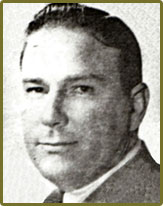
College benefactor Peter Wege, circa 1960. Wege took a leave of absence from Steelcase Corporation in 1959 to supervise the development campaign and the construction of Albertus Magnus Hall of Science and the House of Studies.
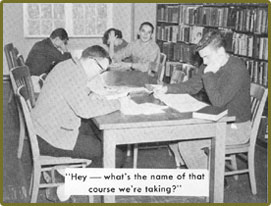
This 1960 photo from The Thomist shows students studying in the library, by then located in the Administration Building.
1960
Albertus Magnus Hall of Science opens for classes in September. The building is dedicated
by Grand Rapids' Bishop Allen J. Babcock. The dedicatory address is given by Fr. William
A. Wallace, O.P. entitled "St. Albert and Modern Science." In recognition of Peter
Wege's service to Aquinas, the building is dedicated to the memory of his parents,
Mr. and Mrs. Peter Wege, Sr.
 To hear physics professor Chuck Frydrych reminisce about the opening days of Albertus
Hall and 1960's science faculty, click here. This audio link is from "Historically Speaking," an oral history of Aquinas College.
To hear physics professor Chuck Frydrych reminisce about the opening days of Albertus
Hall and 1960's science faculty, click here. This audio link is from "Historically Speaking," an oral history of Aquinas College.
A language lab with 42 private acoustic-walled booths is installed. Languages taught
include French, Spanish, German and Swahili, taught by a student from Tanganyika.
Some college classes are offered on closed-circuit TV, and Aquinas drama students
perform on WOOD-TV.
The House of Studies opens for Dominican Sisters in training to live on campus. Sisters
begin living and studying in the building in November. During the 1960's, as many
as 70 sisters live in the residence. In the early 1980's, the building is sold to
the college and becomes Hruby Hall, a residence and office building.
A graduate institute in theology for religious sisters is begun, later to become the
Aquinas Institute of Religious Studies (AIRS). Graduate programs in history and English
are begun and masters degrees are offered in those fields until 1967. (These programs
were discontinued.)
Throughout the 1960s, The Yacht Club, in the nearby Eastown neighborhood, provides
off-campus entertainment for students, and a challenge for directors of student life.
 To hear Betty Jennings, former Aquinas faculty member, reminisce about her days policing
The Yacht Club on Wealthy Street with Dean of Women Gertrude Horgan, click here. This audio clip is from "Historically Speaking," an oral history of Aquinas College.
To hear Betty Jennings, former Aquinas faculty member, reminisce about her days policing
The Yacht Club on Wealthy Street with Dean of Women Gertrude Horgan, click here. This audio clip is from "Historically Speaking," an oral history of Aquinas College.
President Bukowski announces that college enrollment tops 1,000 for the first time
in its history. 48% of the student body is from out of town. The College employs 74
full-time faculty.
1961
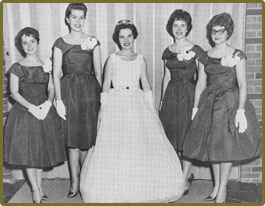
1961 Homecoming Queen Judy Martin and her court pose for their royal portrait.

Fans beat the drum for the Tommies at this 1961 sporting event.

Chris Longcore gets into the spirit of Gala Weekend 1961 by purchasing a hat from the Dominican Sisters 'hat booth.
Baseball and golf teams win city championships in 1961. Athletic flourish in the
1960's, with basketball star Dennis Alexander scoring a career total of 2,034 points,
and John Kurzynowski winning the NCAA college division national championship in golf
in 1964. The Aquinas College golf teams in these years regularly are nationally ranked
and get the nickname "The Yankees of the North" for their winning ways. During this
time, Aquinas joins the National Association of Intercollegiate Athletics (NAIA) when
the NCAA and NAIA rule that colleges cannot hold membership in both conferences.
"Orbit," a collection of student creative writing, is published. Film festivals bring
foreign films to campus, some of them controversial, like Bergman's "Virgin Spring."
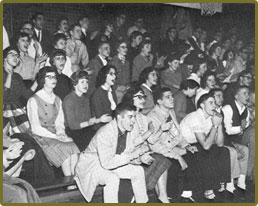
Tommies fans get swept up in the action, 1961.
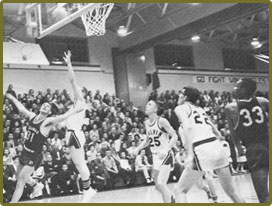
Aquinas College plays before a packed house in this 1962 game against longtime rivals Calvin College.
1962 to 1963
1962
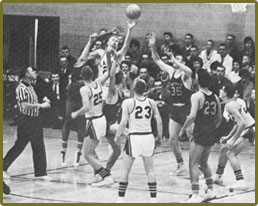
The Tommies and the Knights go for the ball in '62.
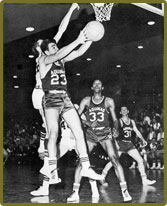
A Tommie works the boards in '62 and
makes the rebound!
Regina Hall opens as a residence for women students.
A Michigan Historical Marker is unveiled in central campus to commemorate the 40th
year of Aquinas College as an institution of higher education, and the 75th anniversary
of its founding as Novitiate Normal School. Monsignor Bukowski celebrates his 25th
year as president of the College.
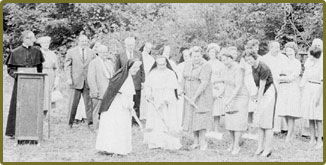
Gertrude Horgan and other dignitaries and students break ground
in 1962 for Regina Hall.

Under Sr. Mary de Chantal Luke and Jack Rang, the Aquinas College theater program takes off, memorably staging "The Importance of Being Earnest" (1962) and "A Man for All Seasons" (1964), as well as many other works of classic and contemporary theater. In 1962, the Aquinas College theater presented Oscar Wilde's "The Importance of Being Earnest" at the Civic Theater in downtown Grand Rapids.
A wooden statue of St. Albertus Magnus, carved by American Seating Company's master
carver Robert E. Hellem, is added to the entrance of Albertus Magnus Hall of Science.
Radio station WXTO continues operating in the tower of the Administration Building.
The station is a collaborative effort with the Grand Rapids Catholic Diocese and is
directed by Father Hugh Michael Beahan. It offers quality music, news, and commentary,
and provides media training for students.

Gwendolyn and Cecily make up in 1962's "The Importance
of Being Earnest."
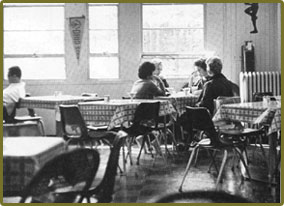
Students gather at "The Hub" of campus life in 1963 for a
quick coffee or a snack.
1963
The College purchases Willowbrook, a large house on Robinson Road adjacent to campus,
to serve as a residence for senior women. (Men continue to live off campus.)
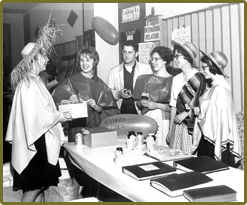
Vatican II brings about changes in liturgy and nuns' habits. Ecumenical and interfaith dialogues take place with members of various Christian denominations and other religions.
1964 to 1966
1964
St. Joseph the Worker Hall opens in September for men students to live on campus.
Located next to Wilcox Park, it is far from Regina Hall, the women's residence hall. In loco parentis rules were in place governing student behavior, with strict curfews and dress codes. To hear alumni Patricia Kozal, Peg Duva and John and Katy McDonald talk about life
in the residence halls in these years, click here. This audio clip is from "Historically Speaking," an oral history of Aquinas College.
To hear alumni Patricia Kozal, Peg Duva and John and Katy McDonald talk about life
in the residence halls in these years, click here. This audio clip is from "Historically Speaking," an oral history of Aquinas College.
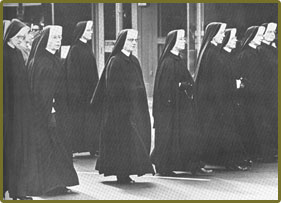
The turbulent 1960s bring the first of many protest marches. Here Dominican sisters march for Civil Rights in 1964.

Errol Harvey directs traffic on Fulton Street as students eagerly await a surprise campaign visit by vice-presidential candidate Hubert Humphrey in 1964.
1965
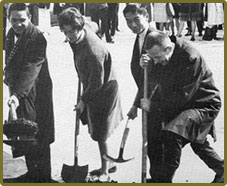
Ground breaking for Wege Center takes place on March 10, 1965. Pictured above are Student Senate officers (left to right): Max Otto, Tamara Paul, Alfred Liu, and Garry Fewless. (Liu later becomes the architect for the Art and Music Center.)
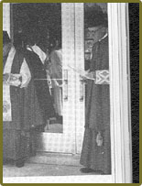
Grand Rapids bishop Allen J. Babcock dedicates
St. Joseph the Worker Hall in 1965.
In his annual report, Monsignor Bukowski noted that "Wege Center, practically from the day it opened, became a student center in truth, with hardly a week or weekend going by without some student club or organization sponsoring an activity." Concerts, Gala Weekend, plays, the annual Carousel of the Arts, and lectures by visiting scholars fill the building regularly.
1966

Students line up to register for classes in 1966.

The final building of the 1960's campus building boom is the Physical Education and Assembly Building which opens with a basketball game pitting the Tommies against the Calvin College Knights. In a good omen for the Aquinas sports teams, the Tommies win that first-ever contest in the new building.
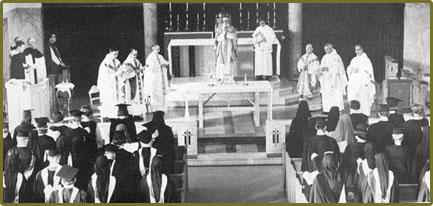
An academic Mass is held at nearby St. Thomas the Apostle parish with Monsignor Bukowski
presiding.
1967 to 1969
1967

In 1967, Aquinas College engineering students build this bridge over Coldbrook stream.
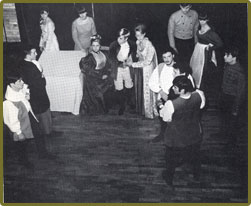
The Carriage House is renovated to make it into a theater. Set up for productions in the round, the theater remains vital for nearly ten years until fire code changes force the closing of the building in the early 1970's. Here, Aquinas College theater students go classical with this 1967 production of Moliere's "Tartuffe" in the intimate Carriage House theater.

At left: The Carriage House theater provides an intimate venue for productions such this 1967 staging of Dylan Thomas's Under Milkwood, with faculty member Herb Martin (seated) and (l to r) Jim Milanowski, William Schultz, Roberta Zimber, and Theresa Grywalski.
1968
Monsignor Bukowski announces his planned retirement, to be effective the following
year. The Board of Trustees sets up a search committee to find his replacement.
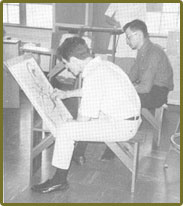
Students perfect their life drawing in this 1968 art class.
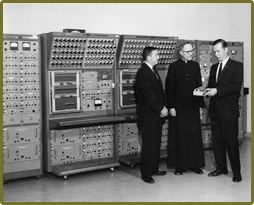
Monsignor Bukowski receives Lear Siegler Inc.’s gift of an analog computer in spring 1968. As Monsignor Bukowski prepared to retire, the world of education was about to change forever.
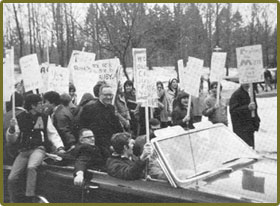
1969
Laymen are admitted to Board of Trustees for the first time. A Lay Advisory Board
has existed since the 1940's but this move inches the College closer to the eventual
legal separation of the college from the Dominican Sisters of Grand Rapids and to
an independent board of Trustees.
 To hear alumnus Russ Hogan talk about this student uprising, click here. This audio clip is from "Historically Speaking," an oral history of Aquinas College.
To hear alumnus Russ Hogan talk about this student uprising, click here. This audio clip is from "Historically Speaking," an oral history of Aquinas College.
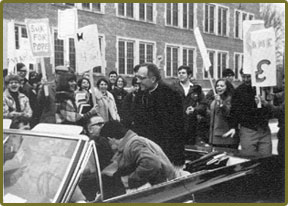
When Monsignor Bukowski retires in 1969, students stage a spontaneous "protest,"
storming the president's office and escorting him around campus in the back of a convertible chanting "Mon Buke! Mon Buke!"
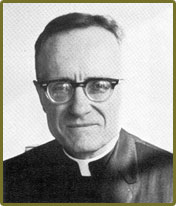
Monsignor Bukowski's portrait at the time of his retirement, 1969.

In his inaugural address, Hruby calls for an institutional self-study that will be a comprehensive revisioning process for the entire College. The self-study, coordinated by professor Lee Jacokes, involves extensive meetings and discussions among students, faculty, administrators and an outside board. The Self Study National Advisory Board members are Dr. Robert T. Blackburn, Professor for the Study of Higher Education at the University of Michigan; The Reverend Carl Hangartner S.J., Professor of Education at St. Louis University; Dr. Ann Heiss, Center for Research and Development in Higher Education at University of California Berkley; Dr. Nevitt Sanford, Professor of Psychology and Education, Stanford University; and Dr. John F.A. Taylor, Professor of Philosophy, Michigan State University. This 15-month process yields a new curriculum, new rules and a new college governance structure that will guide Aquinas through the turbulent 1970's and beyond.
In his first year, Hruby creates Encore, a degree completion program for mature women and empowers professor R.J. Bennett to create an evening degree program in business and accounting.
CONTACT INFO
AQ History
Ryan Wendt
aqhistory@aquinas.edu